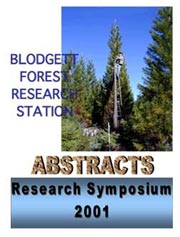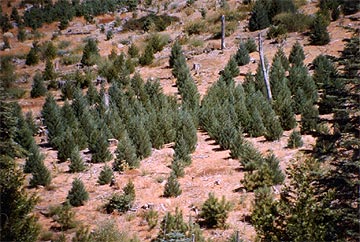This is a three year project focusing on the chemical ecology of the pine engraver, Ips pini, and its predators in Northern California. The goal of this research is to develop means to reduce the removal of predators during bark beetle trap out programs and to increase predator-to-prey ratios in bark beetle-attractive timber harvest sites.
Three studies were carried out:
- To determine which synthetic lures attract actual ratios of predator-to-bark beetles that arrive at host trees.
In this experiment, nine treatments were presented in a behavioral choice test:
1. 3%(+ ):97%(-) ipsdienol
2. 50%(+ ):50%(-) ipsdienol
3. 75%(+ ):25%(-) ipsdienol
4. 3%(+ ):97%(-) ipsdienol plus lanierone
5. 50%(+ ):50%(-) ipsdienol plus lanierone |
6. 75%(+ ):25%(-) ipsdienol plus lanierone
7. Ips pini-infested bolt
8. uninfested bolt
9. blank
|
Three lines of nine Lindgren funnel traps were deployed. Each trap in a given line was assigned one of the nine treatments. Traps were sampled and re-randomized every 4 days for 24 days. This schedule was repeated twice during the spring/summer field season to sample the two flights of I. pini that occur in this area. Ratios of predators to Ips pini (3 major predators, T. chlorodia, E. lecontei, and E. sphegeus combined) varied from 0.4:1 to 10:1 in 1997, and 0.01:1 to 3.25:1 in 1998 . The synthetic lure most attractive to Ips (# 1) had a predator/Ips ratio of 0.08 in 1997 and .01 in 1998. The lure most attractive to predators (#5, mostly E. lecontei) in 1997 had a ratio of 10.0 predators/Ips, while in 1998 lure #6 (mostly T. chlorodia), had a ratio of 1.8 predators/Ips.
- To determine which combinations of synthetic attractants generate the highest bark beetle-to-predator ratios during simulated trap out.
This experiment was presented as a series of no-choice tests in a Latin square design. Six plots were used. Within each plot, nine traps were deployed in a 3X3 grid and baited with one lure type (using the same six synthetic lures as in objective 1). For two years with two runs each year, Ips pini was attracted to two lures (#1 and #4) in significantly higher numbers than all other lures. Also for both years, the predator Enoclerus lecontei was significantly more attracted to lures (#6 and #5) that were not highly attractive to Ips pini. Ratios of E. lecontei to Ips pini caught varied from 6.7 to 1.5 (mean 2.1) for these two lures. The predator Temnochila chlorodia was much more abundant in 1998, run 1 than in the other three runs. The ratios of T. chlorodia per Ips caught were highest for lures 2, 3, 5, and 6 (4 to 5.9 T. chlorodia per Ips). Combining Enoclerus sp. and T. chlorodia for both years, the treatment lure with 50%(+ ):50%(-) ipsdienol plus lanierone, gives the best predator to Ips pini ratio (4.96).
- To determine the synthetic attractants that would most augment predator arrival rates.
This experiment was presented as ten pairs of prepared slash piles, with one pile of each pair selected randomly and treated with three units of 50%(+ ):50%(-) ipsdienol plus lanierone attractant. This lure (from experiments above) attracted the highest predator/Ips ratio with the greatest total attraction of both the common predators E. lecontei and T. chlorodia. Each pile pair consisted of two limbed trees cut into four 1.5m bolts, with two bolts from each tree in each pile (four bolts per pile). Piles were covered with freshly cut limbs from the cut trees to shade them from the sun. Each pair of piles was separated by 40m and within the pair by 20m. Two 20cm-square sticky screens were attached with duplex nails just off the surface of the bark of the top bolt, on shade side, 1/4 of the length in from each cut ends of the bolt. The experiment was started on 28 May, 1999, when Ips began to be detected in survey traps. Screens were changed every 3 days for the next three weeks. On the last collection day three 30cm bolts were cut from logs in each pile and returned to our laboratory for rearing. All screens were examined for numbers of Ips, predators, and other associated insects by species, and we recorded all insects emerging from the laboratory-rearing bolts. The data from capture on screens has been analyzed: we found that the ratio of the bark beetle predators to Ips pini was only 0.16:1, much lower than expected from the studies in 1997-1998. We also found much higher numbers of anthocorids compared to the trap studies. These results may indicate that artificial trap catches may not be representative of actual arrival rates on slash piles.
 |
|
Photos courtesy of California Conservation Corp, Greenwood
|
REGENERATION:
An average of 22,000 seedlings are planted at Blodgett Forest every year. Cones are harvested in the fall from the best trees of each species – the tallest, straightest, fastest-growing – and seeds extracted. The seeds are taken to a forestry nursery and planted to be retrieved for planting at two years and 8 to 12 inches tall. Seedlings are planted approximately 400 to the acre.
|
|
|
|





